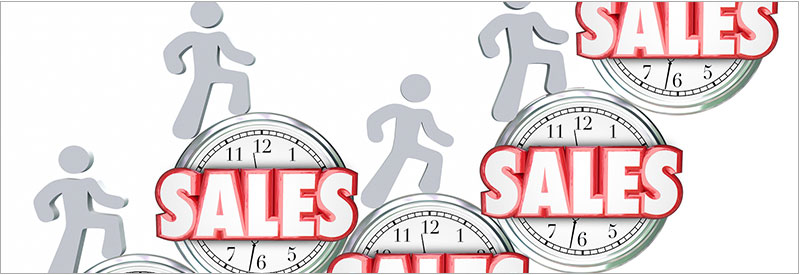1 min read
Most Staffing Firms are Not Built to Scale, But to Survive
Most staffing firms don’t struggle to scale because their teams aren’t working hard. They struggle because they don’t have a real go-to-market...
4 min read
![]() Dan Fisher
:
Jun 7, 2016 8:30:00 AM
Dan Fisher
:
Jun 7, 2016 8:30:00 AM

Wouldn’t it be great if 90 percent of your sales reps achieved their quota 100 percent of the time? The bad news is, with the approach most firms take to sales and sales training, performance like this is well out of reach.
If your firm is like most of the ones I’ve encountered in my two decades of coaching IT staffing companies throughout the country, your sales reps’ quota attainment is wildly uneven. Some reps dominate from month to month while most others struggle to meet their quota. You can get whiplash trying to follow your reps’ gross profit margins.How is it possible that a sales rep selling the same services for the same company to virtually the same customers can average 22 percent gross profit margins and while another sales rep is averaging 27 or even 30 percent gross profit margins?
The problem is you lack a consistent, effective sales methodology.
The good news is, when your sales team uses a sales methodology, you can have the kind of results I talked about at the top of this article. As referenced in this whitepaper by Cappco Partners:
"According to the Accenture analysis included in the Sales Performance Optimization Study sponsored with CSO Insights, between 36 to 47 percent of sales representatives have failed to reach their annual sales quota numbers. Whereas, 92 percent of representatives who consistently used a sales methodology achieved their quota.”
92 percent — not bad. How can you create a sales methodology to get results like that from your team?
Here are the basic steps involved:
Step 1: Map Out Your Firm’s Buyer Aligned Sales Process
Wait. Up to this point, I’ve been talking about the need for a sales methodology. Now all of a sudden I’m talking about a sales process.
No. While the two terms are related, and both are necessary for growing your firm, there is a difference. A buyer aligned sales process maps out all of the steps that a rep and customer must complete for a deal to close. Your sales process focuses on your opportunities (job orders) and the steps that your prospect must complete for your opportunities to close. Your sales process is not a call plan or call script, nor is it account planning or strategic account development plan.
Your sales methodology is how you execute the steps in your sales process. Your sales methodology details how you will compel your prospects to move from one stage of the sales cycle to the next. A methodology includes playbooks like a call plan, cold call script, account planning and qualification criteria.
But the first step is to map out your sales process.
To get started, ask yourself, “How will my typical prospect (a hiring manager) go from knowing nothing about me and my firm to becoming familiar with me and my firm and comfortable enough to giving my firm an opportunity for the business?” In other words, what is your buyer’s journey? Most buyers do the following before engaging a new vendor:
Second, map out all of the steps that your customer must complete in order to hire a consultant or temporary employee from you and your firm. For example, once they decide to give you the opportunity, they may still need to get approval from HR, finance, procurement, the CIO, or another business unit. They may need to interview internal candidates or candidates sourced from their internal recruiters. They will have to screen resumes, schedule interviews, conduct reference checks, procure a workstation or laptop, and eventually get a purchase order approved.
Those are just a few of the steps a typical hiring manager has to complete in their purchasing process before hiring a consultant or contractor. The point is, your sales process needs to align with how your prospect will complete all of these steps. This is how you ensure your sales reps stay in alignment with your customer.
You can uncover your customer’s purchasing process by simply talking with your sales reps and interviewing your customers.
By beginning the process by mapping out your customer’s purchasing process and how they wish to engage your sales reps, you will increase the likelihood that your sales reps will always keep the prospect’s needs front and center throughout the sales cycle and will not fall into “pitch mode,” like legacy or transactional sales reps. It will also ensure the sales rep is perceived as helpful by the prospect because the sales rep is trying to guide the prospect through their buying process, not completing a sales transaction.
Step 2: Develop a Methodology to Execute Each Step of Your Sales Process
What are the customer touch points within each step of your sales process? This is where you discover whether your current sales methodology gives your reps any best practices to work with or leaves them up to their own devices (which is, to say the least, not ideal) to figure it out on their own.
For each touch point, you want to clearly outline what the prospect is doing and what specific action you want the prospect to take and commit to. You also need to define how your sales rep should engage the prospect and compel them to take that action. This includes how the sales rep prepares for each touch point, how they will open the conversation and establish expectations, what questions will be asked, and how common questions and objections will be addressed.
Finally you need to establish criteria for whether a prospect has committed to taking action and has moved to the next step. It should be objective and verifiable.
Step 3: Create Qualification Criteria
You have now mapped out your prospect’s purchasing process and the steps they must complete in order to engage with you and your sales team. You also understand that you must detail your sales methodology: how you will compel your prospects to move from one stage of the sales cycle to the next.
Now you must define your qualification criteria. Qualification criteria is the information you need to capture from the prospect in order to understand:
From here, there are number of other qualification elements that you should consider incorporating. For instance, with our sales methodology, we apply qualification criteria at the lead level, account (company) level, and opportunity (job orders) level.
For opportunities we also include qualification criteria such as:
To name a few.
An Example of How Sales Process and Sales Methodology Comes Together
Let’s say the first step in your sales process is prospecting. In this case, your methodology might include the specific details of:
|
Sales Cycle Stage |
Sales Methodology |
Qualification Criteria |
|
Prospecting |
|
|
As you can see, a well-defined sales methodology is very specific for each step in the sales process. The more specific it is, the more repeatable — and therefore trainable — it is.
If mapping out and building all these steps seems like a lot of work, that’s because it is. Do you have to build your own sales methodology or are there other options available?
That question (and five more) are answered in my recent ebook, “Sales Methodology 101 for IT Staffing Firms: Your 6 Big Questions Answered.” Follow the link for your free copy.

1 min read
Most staffing firms don’t struggle to scale because their teams aren’t working hard. They struggle because they don’t have a real go-to-market...

In my previous post, How to Prevent Unexpected Contract Terminations, I shared how systemizing consultant and client check-ins at key milestones...

About a year ago, I was serving as the fractional revenue leader, managing sales and recruiting for a client.